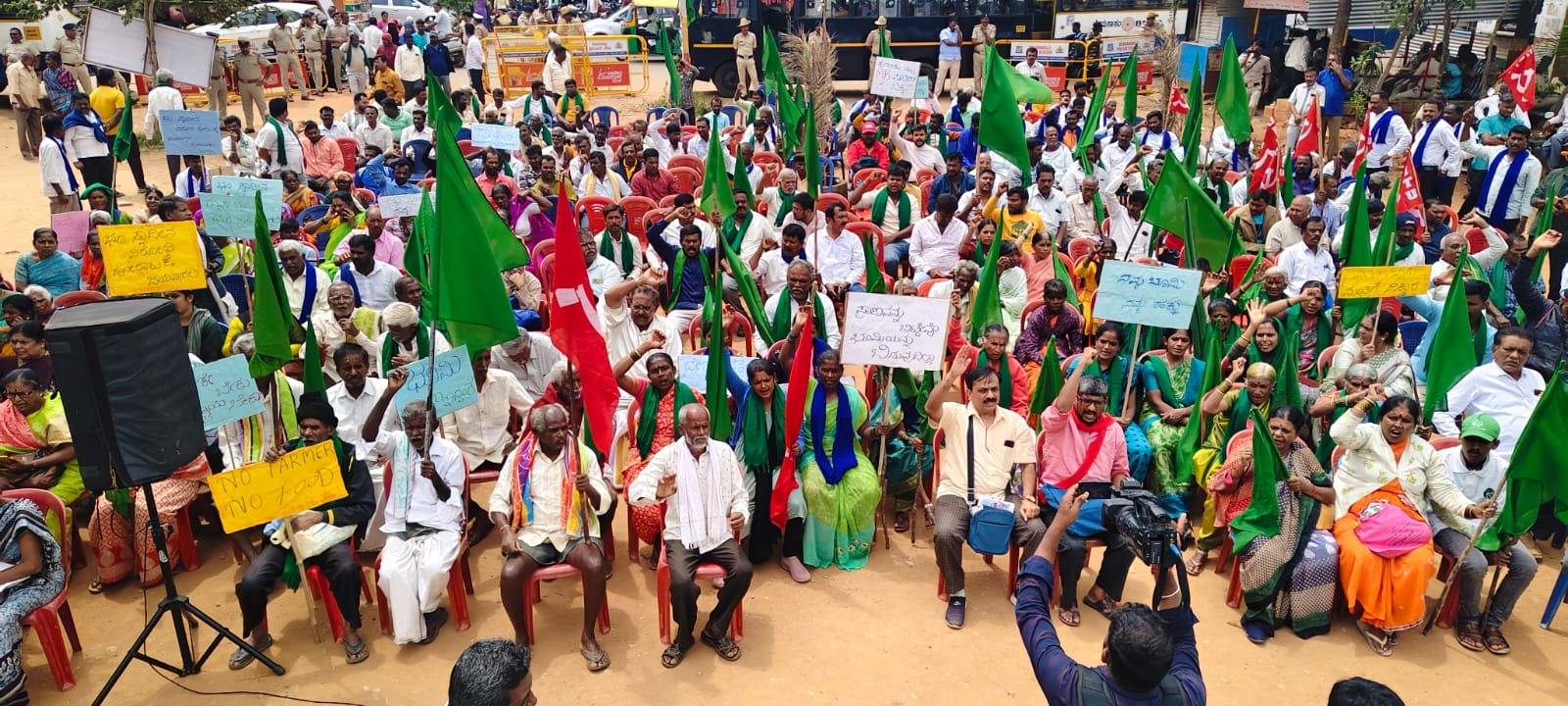India: Peasant Movements Protest Forceful Acquisition of Farmland Near Bengaluru Airport

For the past 842 days, small-scale farmers and allied agricultural workers’ unions in Channarayapatna, Devanahalli, near the Bengaluru International Airport, have been leading a protest against the acquisition of their land for an industrial project. A rich agricultural belt, the region supports a variety of horticulture, sericulture, animal husbandry, and other agricultural activities. These include the cultivation of finger millets, the famed Bangalore blue grapes, a wide variety of vegetables and fruits, and more recently, flowers.
According to news reports, the Karnataka Industrial Area Development Board (KIADB) is set to acquire 1,777 acres for the Haralur Industrial Area Development Project (Phase II). In Phase 1, the board developed an industrial area spread over 1,282 acres, where two companies have set up production units. The preliminary notification for the acquisition was issued on August 30, 2021.
About 700 farming families will be affected by this project. Up to 475 acres are owned by farmers from historically oppressed communities and indigenous people in the area. Reports also indicate that nearly 6,000 people are engaged in farm work in the area.
On July 22nd, the Karnataka Rajya Raitha Sangha, Hasiru Sene, Dalit Sangarsha Samiti, and several other allied organizations, under the banner of ‘Bhoosvadhina Virodhi Horata Samithi’ (Anti-Land Acquisition Struggle Committee), organized a rally at Devanahalli and led a protest march on foot to the Chief Minister’s residence in Bengaluru. However, they were stopped and detained by the police.
Before taking out this protest march to the Chief Minister’s residence, over the last many months the protesting farmers had repeatedly met with several prominent ministers from Karnataka. Very recently, a national-level delegation of farmer leaders led by Rakesh Tikait and Yudhvir Singh also met with Siddaramaiah to discuss the land acquisition issue. However, according to the farmers, final notices about the land acquisition were served to two villages the very next day.
“Finger millet, a crop high in nutritional value and closely linked to the traditional diet of the communities, is the most grown crop in the area. The land is also used to cultivate grapes, beans, mangoes, and a host of other vegetables. Many residents are also small-scale livestock owners, and the land is crucial for grazing. How could anyone snatch away this land that feeds the city?” Pramod Polanahalli, a young peasant from the community and organizer with the KRRS, pointedly asks.
According to a survey conducted by the affected peasant families in the area, about 1,000 tonnes of ragi (finger millet) and other food grains, 2,000 tonnes of grapes, 150 tonnes of mangoes, and other produce are grown on this land. Up to 8,000 liters of milk are produced every day in 13 villages, and dairy farming is a major source of income for farmers.
“Nearly 50% of the land is rain-fed, making it fertile. Out of the earmarked 1,292.1 acres of land, nearly 42% were granted by the government to landless people as part of an earlier land reform policy. The remaining peasant families have been farming here for generations. Farming is our life; it’s all we know,” adds Karahalli Srinivas, a leader with the Dalit Sangarsha Samithi, at the forefront of the struggle.
Srinivas’s views also found echo among other protesters who said that farming is more than a means of livelihood and that the land and the farms are closely linked to their identity, culture, and heritage. For over two years, protesters have been camping at the site – sending 35-40 people from their communities daily. During the recently concluded national elections in India, the peasants in the region had announced a boycott of the national elections if politicians – from all political parties – continued to neglect their struggle.

Peasant leaders of the KRRS who were protesting on 23rd July have also raised concerns about clearing large swathes of green land for industrial-scale manufacturing at a time when the city is battling a water crisis, the agrarian sector is in distress, and extreme weather events – droughts and untimely rains – are increasing in frequency.
“KIADB has already acquired thousands of acres of land in Channarayapatna Hobli for various projects. More than 80% of the farmers have refused to give up their land. Our fight for the land will continue, and will be intensified. This is a clear case of turning fertile, productive land – nearly half of it rain-fed – that houses and employs a large number of families and cultivates nutritious crops that are ecologically and climatically suitable to the area. These farmlands are essential to our biodiversity and food sovereignty. Why can’t the government move these manufacturing zones elsewhere? ”, said KT Gangadhar, senior leader of KRRS

“The trend of forceful acquisition of farmland has been ongoing in the country for two decades. This is done in the name of development, to attract foreign investments and generate employment opportunities. Over this period, more than 500,000 acres have been acquired, with most of it not used for setting up any industry but for speculation. In their concept, producing milk, vegetables, fruits, and flowers is not considered development, although these sectors contribute 18% to India’s GDP. Development, to them, means gambling with the lives of the vulnerable and voiceless. Regardless of which party is in power, they are all pro-capitalist” Chukki Nanjundaswamy, KRRS added.
As per the latest reports, ‘Bhoosvadhina Virodhi Horata Samithi’ (Anti-Land Acquisition Struggle Committee) has decided to escalate the protests if no immediate resolution is found on this issue.
The article has been prepared based on inputs from KRRS members and various media reports.
